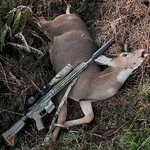Boltgun
Lil-Rokslider
- Joined
- Apr 13, 2023
- Messages
- 199
If only someone were conducting these studies on living creatures and compiling the data, perhaps onto an online location, like a forum?Thanks for the thoughtful reply and I am enjoying this thread. I would point out that gel models are not particularly good indicators of terminal ballistics in warm-blooded creatures and humans. In particular, the viscoelastic properties of ballistic gelatin poorly reflect the anisotropic nature of human or animal soft tissue. And of course, homogenous and isotropic material of any type cannot be used as a proxy for bone. Really, the best source of data, uncomfortable as it is to say, is empirical evidence from careful measurements of actual wound channels. But that's seriously compromised by unknown variables such as range, angle of impact, external clothing, etc.
Enough anecdotal evidence becomes data, and some of the threads on here are beginning to have A LOT of evidence that includes wound channel width and depth, as well as range and impact velocity. Although clothing really hasn’t been addressed, not too many deer or elk wearing Carhartt’s!



